1974 Ford Thunderbird Burgundy Luxury Group: Big Bird
Today, we discuss Maximum Thunderbird. The extra value T-Bird, aka the Thunderbrougham. The biggest ‘Bird. Long, low and wide. And proud if it. Yes, that’s correct, the 1972–76 Ford Thunderbird, which shared its ample dimensions with the even more luxurious, and Frank Cannon-approved, Lincoln Continental Mark IV.
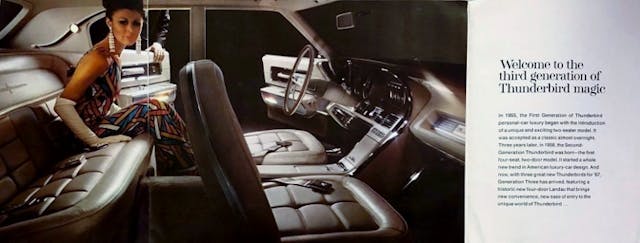
This was not the Thunderbird’s first drastic change, of course. Indeed, the iconic premium Ford reinvented itself many times. The 1958 Thunderbird, nicknamed the “Squarebird” for obvious reasons, was very different from the trim two-seat luxury sportster of 1955–57. The big news, of course, was the addition of a back seat. Although fans of the “Little Bird” were beside themselves with the change, sales improved drastically. And with its “cow belly” frame it was still substantially lower than contemporary Fairlanes and Country Sedans. It ushered in a new type of car: a luxury Ford.
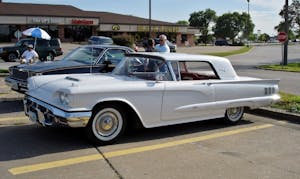
The Squarebird held sway from 1958 to 1960. Only minor details differentiated the three years, consisting of revised grilles, taillights, and upholstery.

The Bullet Bird replaced it in 1961, a very pleasing mode of suburban sport/lux transport for the jet age. Ford really had a knack for creating new market niches, and the T-Bird was one of its best ideas. Folks who would never have considered a Ford in the past, people who were doctors or lawyers and drove Lincoln Continentals, Buick Electra 225s, and Oldsmobile Ninety Eights, were looking at—and buying—Ford’s personal luxury coupe. It was a whole new world.
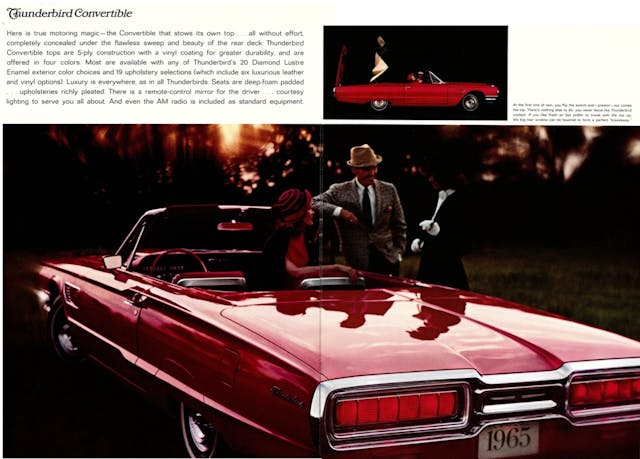
My grandparents, Bob and Ruby Klockau, were such people. When my dad was growing up in the early 1960s, my grandfather, who was a lawyer, had a black circa 1962 Buick Electra 225 four-door hardtop. My grandmother had a metallic lavender 1959 Pontiac Catalina convertible with a white interior and a white top. Before that, she had a 1956 Pontiac station wagon.
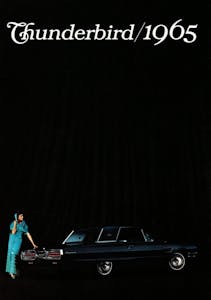
That ’59 was given to my Uncle Chris, who was in high school at the time. He quickly turned it into a hot rod. Meanwhile, Bob and Ruby went down to Bob Neal Ford in Rock Island, and bought a brand new navy blue ’65 Thunderbird convertible with a white interior and navy blue carpeting and instrument panel. She loved that car. So much, that she kept it all the way to 1977. Whenever small rust spots would appear, she immediately took it over to the dealer’s body shop, where it was fixed and painted to match.

With the 1964 to 1966 T-Birds, the smooth, swoopy looks of the 1961–63s gave way to a more squared-off, formal look. A bonus was one of the coolest interiors of the Sixties.
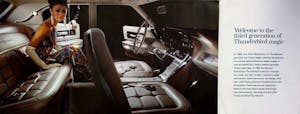
Much was new for the 1967 Thunderbird, and interior coolness remained a high point. For the first time, there was no longer a Thunderbird convertible; a victim of changing tastes and declining sales. In its place, a new Landau four-door appeared, with center-opening doors a la Lincoln Continental. The sedan was prominently featured in showroom brochures and advertising, but of course the two-door hardtop and two-door Landau remained available.
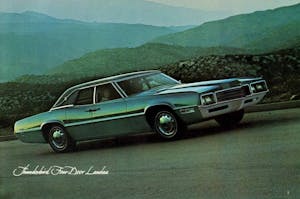
In 1970 the two-door Thunderbird received a new, sportier roof line, and all T-Birds got a “Bunkie Beak”, nicknamed after Ford’s CEO, Bunkie Knudsen, formerly of General Motors. During this time, sales slowly but surely declined, from 77,956 in ’67 to only 36,055 in 1971. Part of that was that the 1970–71, despite the facelift, was still recognizable as the 1967 under the new sheetmetal, and all-new, more compelling choices appeared in 1971, particularly the Eldorado, Toronado and extra-compelling boat-tailed Buick Riviera. A new direction was needed, and a heavy facelift was not going to do it this time.
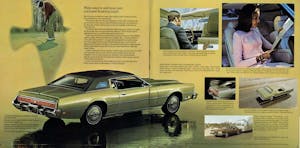
And so it was that the 1972 Thunderbird was all-new, fresh, and most certainly up-sized. More wheelbase, more front and rear overhang, more luxury gadgets. The 1972 Thunderbird was completely redesigned and had quite a lot in common with the also-new-for-’72 Continental Mark IV. The four-door Landau was gone; never to return.
The 1972 Thunderbird and its Mark IV cousin were approved by Ford President Bunkie Knudsen just before his departure from Dearborn. Total length was now 214 inches, with a 120.4-inch wheelbase and 80-inch width. The 1972 model came in a single Landau two-door hardtop model and was priced at $5293. Sales rebounded smartly, to the tune of over 57,000 units.
The 429-cubic-inch V-8 was standard equipment on the 1972 T-Bird, with a 460 optional. Either way, you could have any transmission you wanted, as long as it was the three-speed C6 automatic. As previously mentioned, the ’72 shared a lot of parts with the Mark. The windshield and side glass were identical between the two, same chassis, same engine, and most of the metal bits under the sheetmetal, too. The biggest differences boiled down to exterior and interior styling: seats, gauges, front and rear end appearance and wheel covers.

Thanks to the 1973 federal bumper standards, the ’73 T-Bird got a new nose, with requisite chromed battering ram, new grille, headlights in separate pods, and new, larger parking lamps. Also new was the opera window. It first appeared on the Continental Mark IV in 1972 as an option, was made standard in 1973, and then the T-Bird got its own version that same year. It was initially an option (like on the ’72 Mark), but was also made a standard feature soon after. Sales went up again, with over 87,000 Thunderbroughams sold for 1973.

Five-mph bumpers were added to the back of all 1974 T-Birds to match the front one, with restyled taillights as well. One of the T-Bird’s defining features, bucket seats, were eliminated in 1974. I don’t think I’ve ever seen a 1972–73 Thunderbird with buckets and console. I wonder what the take rate was.
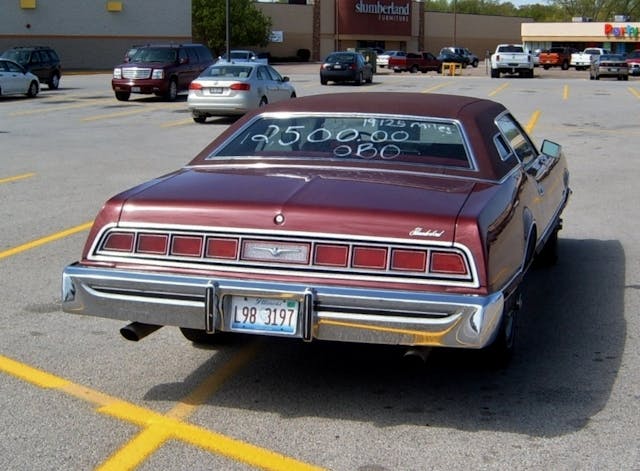
Thanks to the new rear bumper, curb weight was up to 4800 pounds. The 429 was dropped and all Thunderbirds now had the 460 as standard, for a less than stellar 11 mpg. Of course, this was a premium car, and folks ponying up for a new T-Bird were likely not concerned with such things. As the man said, if you have to ask, you can’t afford it …

Between 1974 and 1976 the Thunderbird received very few updates, primarily new colors and wheel options. Ford kept interest up with lots of special decor models. Today’s featured car is a Burgundy Luxury Group Thunderbird, which was available in 1974 only. It included special burgundy metallic paint, color-keyed vinyl roof and premium bodyside moldings, and a burgundy interior in velour or optional leather. I remember seeing an ad for it when I was in grade school in the ’80s, leafing through our science teacher’s vintage cache of National Geographic magazines.
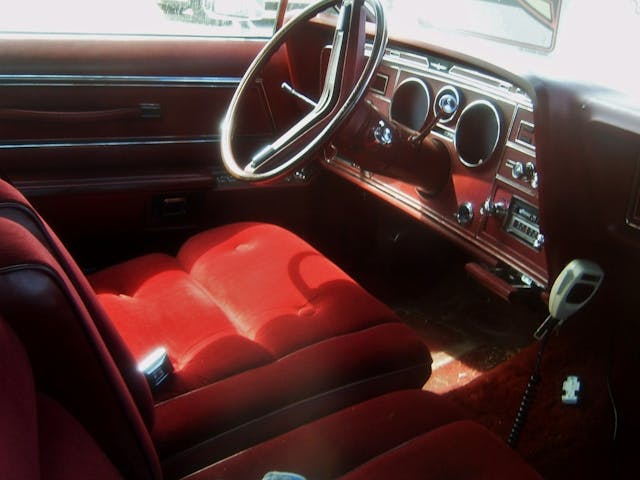
Inside, the Thunderbird had its own unique door panels, upholstery, and instrument cluster, featuring round gauges set in a color-keyed panel, unlike the Mark IV’s rectangular gauges swathed in two different styles of woodgrain trim. As much as I love the Mark IV, I kind of like the Thunderbird’s instrument panel treatment better. This particular survivor also has a CB radio, which was all the rage in the mid-to-late ’70s. “Bandit, this is Velour Bird headed eastbound on I-55. Any Smokeys headed my way?”
While the Continental Mark IV was the cream of the crop in Ford’s personal luxury coupe lineup, an argument could be made for choosing the Thunderbird instead. Consider that the 1974 Thunderbird had a base price $7330 while the Mark IV was a princely $10,194. For nearly three thousand dollars less—a not-inconsiderable sum in 1974—you could get a very comparable car. That is, assuming you could live without the chrome Parthenon grille, hidden headlights, spare tire hump, and oval opera windows. The Mark had many features that were standard on it but optional on the T-Bird, but still, the Ford was probably a better deal even with that factored in.

Despite this, sales of 1974 Marks and T-Birds were neck and neck, with 57,316 and 58,443, respectively. But then, Frank Cannon drove a Mark IV on TV, not a Thunderbird. There was no mistaking the snob appeal of the Lincoln. And I can’t help but love the Mark IV. Cannon is one of my favorite ’70s TV shows. I mean, he loved supper clubs and fine dining, lived in a penthouse, drove a Mark, and fought crime. What’s not to like?
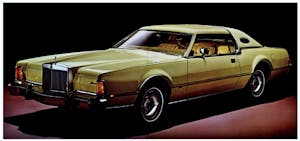
By 1976 there were no less than three Luxury Groups available for the Thunderbird: Creme and Gold, Bordeaux, and Lipstick. But that was nothing compared to the Lincoln, which had Lipstick, Light Jade/Dark Jade, Blue Diamond, Jade/White Desert Sand, and Cream and Gold Luxury Groups, not to mention the ultimate snob appeal Designer Series models.
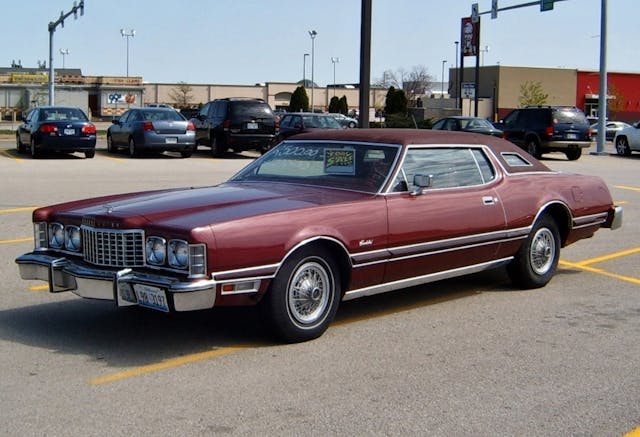
The Lipstick Luxury Group was the sharpest choice whether Mark or Thunderbird, in my personal opinion. Bright red paint, bodyside moldings and vinyl roof graced the exterior, while inside was white vinyl upholstery (or optional leather) with red-and-white door panels, and red carpeting, seat belts and instrument panel. It made for quite the flashy machine.

Back in April of 2012, my brother Andy told me about a cool ’70s Thunderbird he saw sitting parked in Moline. I tracked it down the very next day. This ’74 model was in great shape, with only a little rust around the cornering lamps making it less than pristine. If you believe the sign, it only had 19,125 miles on it. It was very cool to see. At that time I hadn’t seen one in a long time, though over the past few years I have seen a couple nice ones at car shows, including a beautiful 1975–76 model in navy blue with a white top, at a show in Nauvoo, Illinois.

After 1976, the T-Bird went on a diet and lost its relationship with the Continental. In fact, it would be essentially an LTD II with hidden headlights and a special “basket handle” roofline, but it would set records for T-Bird production.
Despite the angst regarding the 1977–79 “LTDBird” these days in certain corners of the Internet, it was a handsome car and had a very appealing price. I’ve always loved the roof treatment, with that angular opera window. But this burgundy ’74 and its 1972–76 brethren show how Thunderbird welcomed the Peak Brougham era.
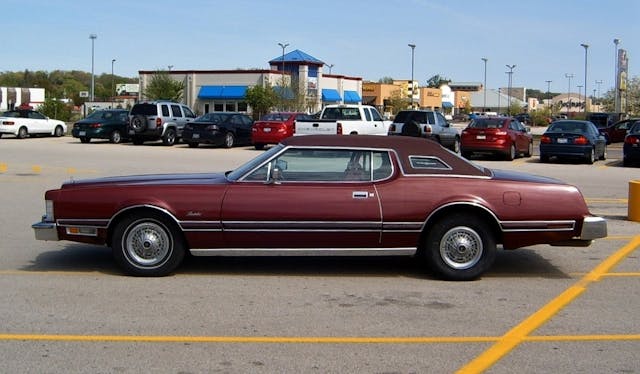
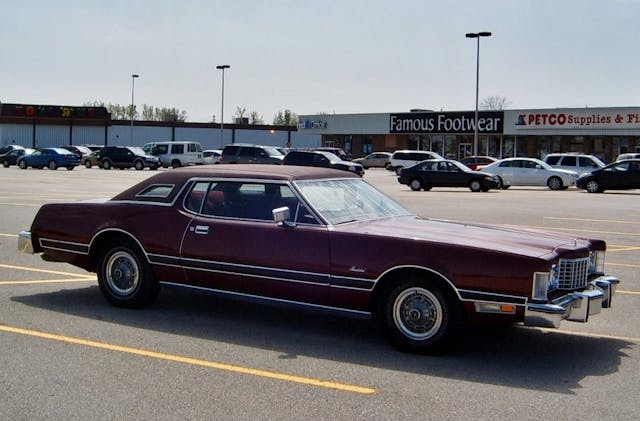
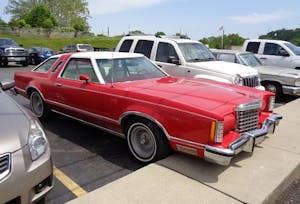


My number one favorite Thunderbird is the 57. I liked how it looked so much like the 57 Ford Fairlane. That was a great idea, that no other manufacturers had done. That said I like all the generations of the Thunderbirds. Each generation was it’s own, and yet they are all Thunderbirds with relationships to the generations that came before. My second place Birds are the 70 and 71. I actually owned a 70. Even though the Bunkie beak was nobody’s favorite, it’s definitely one of mine. From the beautiful dash and interior, to the full length taillights and their sequential turn indicators. However the problem was it’s size and weight required it to have a lot under the hood. The big block 428 4 bbl Motorcraft carburetor was a good fit, but 8 mpg was not a good fit due to the 73 oil crisis. As beautiful as they were, they could barely be given away because of the low mileage. My number 3 all time favorites is the 74, through 76s. Even though they are brothers with the Lincoln Mark lVs, the Thunderbirds have a certain elegance that stands on it’s own.